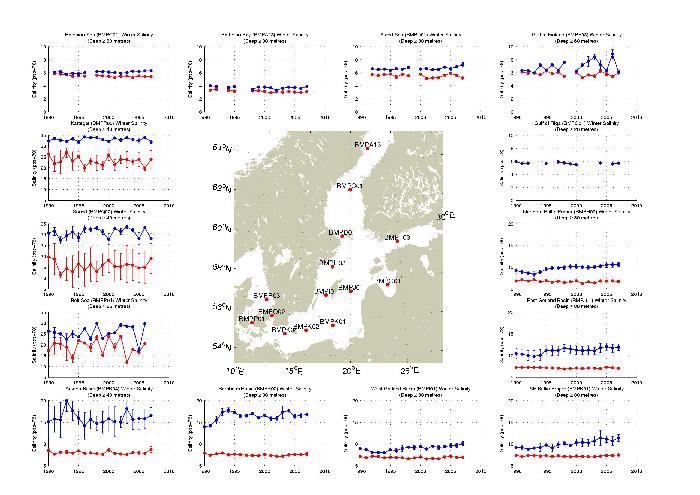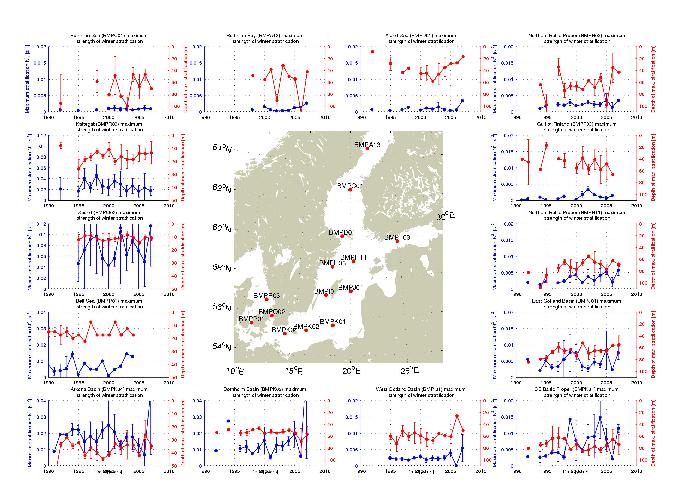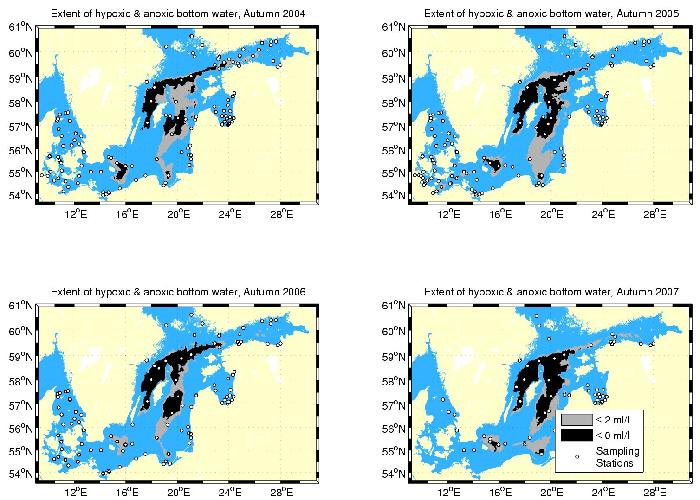Hydrography and oxygen in the deep basins
|
||||
Key message:
There has been a steady worsening of oxygen conditions in the deep basins of the Baltic Proper since the saline inflows of November 2002 – March 2003. In the South Eastern Baltic Proper, Western and Eastern Gotland Basins and Northern Baltic Proper, deep water salinity has increased, making the ventilation of these deep basins less likely.
Results and assessments
Relevance of the indicator for describing developments in the environment
Salinity, temperature and oxygen are physical supporting parameters. They constrain biodiversity, fish recruitment and water quality in a semi-enclosed water body such as the Baltic Sea. For example, cod larvae are dependent on water with salinity and oxygen levels above 11 psu and 2.1 ml/l, respectively, which only occur regularly in the Bornholm Basin at present.
Baltic surface waters are strongly influenced by run-off of freshwater from land. Changes in run-off alter the surface salinity while inflows through Öresund and the Belt Sea control the salinity of the deeper waters. Stratification between the upper and lower layers inhibits surface and deep waters mixing together, and thus preventing the oxygenated surface water penetrating to depth, as well as hindering the transfer of phosphorus (which is abundant in the deep water) to the surface waters. Stratification strength can be indicated by the salinity difference between the surface and deepwater, as well as by the buoyancy frequency (a function which incorporates the effects of both salinity and temperature changes) and by the depth of the pycnocline i.e. the volume of the deepwater. Figure 1 shows the difference between surface and deep salinity.
Figure 2 presents the depth of maximum winter stratification, and also the strength of that stratification, based on calculations of the buoyancy frequency (a function of the change in density with depth). Winter stratification was used, so that the effect of thermal stratification (strong in summer) would not disturb the signal. Stratification strength is as expected: weakest in the Bothnian Bay and Gulf of Finland, and strongest in the Belt Sea and Öresund. Variability in pycnocline depth is great. The standard deviation of estimates within a season can be more than 20 metres, particularly where the stratification is weak, making it difficult to determine trends with any confidence. Figure 2 shows the strength of the pycnocline (in terms of the buoyancy frequency) and also its depth.


Oxygen depletion is widely used as an indicator for the indirect effects of nutrient enrichment. Eutrophication leads to increased primary productivity. As this production decays, oxygen is consumed. Oxygen levels above 4.5 ml/l are considered to cause little problem; levels below this cause increasing stress to most organisms. Below 2.1 ml/l, cod eggs die. Recurrent episodes of low oxygen concentration leads to the extinction of benthic communities, and their replacement by bacterial mats. At very low oxygen concentrations, large amounts of phosphate are released from bottom sediment, which can worsen eutrophication, stimulate cyanobacterial blooms, and lead to yet lower oxygen concentrations in future.
Lowest oxygen levels are experienced at the end of summer, between August and October, when detritus from biological activity in the surface waters has sunk, and is decomposed by bacteria. This process consumes oxygen. When oxygen concentrations fall below about 1 ml/l, bacteria start to use anaerobic processes, producing hydrogen sulphide. Hydrogen sulphide is toxic, and its concentration is described in terms of negative oxygen. In the western Baltic Proper, Danish Straits and Kattegat oxygen depletion is a seasonal phenomenon which occurs during autumn. The deepwater basins in the Baltic Proper however suffer severely from long-term oxygen depletion.
For each of the basins, autumn (August, September and October) oxygen profiles from 1990 – 2006 were examined. Depths at which the oxygen concentration fell within certain limits (<0; 0 – 1;1 – 2.1; 2.1 – 3.5; 3.5 - 5 ml/l) were calculated, and these values were interpreted in terms of the volume of water in each basin affected by reduced oxygen levels as a percentage of the total basin volume. Figure 3 shows the development of hypoxia with time at monitoring stations in the Baltic.
Figure 4 shows the extent of anoxic (water totally free of oxygen) and hypoxic bottoms in the Baltic during the past four years.


Policy relevance and policy references
Oxygen levels are used as an indicator of eutrophication by both Helcom and OSPAR. It is listed as a core variable of the HELCOM COMBINE programme. Oxygen is delivered to the deep waters of the Baltic in the saline inflows that come through the Sound and Belt Sea, these inflows strengthen the stratification of the Baltic Proper however, which hinders the vertical transport of oxygen to the deep water. Hydrographic measurements (temperature and salinity) allow us to trace the inflows, and other water movements within the Baltic. The vertical stratification, which is governed by the temperature and salinity, inhibits the vertical exchange of heat, salt, nutrients and oxygen, and describes the separation between ‘surface’ and ‘deep’ waters.
Assessment
Surface salinity has remained fairly constant in the Baltic Proper since 1990, although it has decreased slightly in the Bothnian Sea. Deep water salinity levels in winter 2007 – 8 in the Bornholm Basin, south eastern Baltic Proper, East Gotland Basin and Northern Baltic Proper remain high, and if anything are higher than after the inflows of 1992 - 1993. While this indicates that further inflows have occurred, they have not had a noticeable impact on the oxygen concentration, and have served only to hinder vertical mixing, which could otherwise have oxygenated at least some of the sea floor.
Stratification strength has been steadily increasing in the Northern Baltic Proper (station BMP H11) and is high throughout the rest of the Baltic Proper.In the East Gotland Basin, the depth of the maximum stratification has decreased since 1995, indicating an increase in bottom water volume. The opposite change occurs in the Gulf of Finland, where the deepening pycnocline reduces the volume of bottom water. As the deep water of the Gulf of Finland is prone to seasonal hypoxia, this reduction in volume indicates an increasing vulnerability, as the volume of oxygen available in the deep water also decreases.
The deepwater basins in the Baltic Proper suffer severely from long-term oxygen depletion. Inflows from the North Sea are currently the principle source of oxygen in the deep water. Between 1991 and 1993, at the end of a long stagnation period, a series of inflows finally oxygenated the deep water, to the extent that hydrogen sulphide had almost disappeared from the deep basins around Gotland. In the Bornholm Basin, levels were above 2 ml/l throughout the water column. This inflow also strengthened the stratification of the deep basins however, reducing vertical mixing, and despite the smaller 2002 – 3 inflows, hydrogen sulphide has returned, and now affects more than 10% of both the East and West Gotland Basins and Northern Baltic Proper. At this oxygen concentration, phosphorus is released from bottom sediments, which has the potential to cause even worse eutrophication should it enter the surface waters. In all these basins, around 40% of the water has oxygen levels below 1 ml/l. This is acutely toxic to benthic fauna, and the sea bottoms covered by this water can be considered dead. This has an impact on benthic and demersal fishes, such as cod, which prey upon benthic animals.
In the Bornholm Basin, anoxia is more seasonal. With the exception of the inflow years 1992 – 3, the basin volume affected by levels below 1 ml/l has remained rather constant since the second half of the 1990s. Between the Arkona Basin and the Kattegat, autumn oxygen levels were normal for the autumn, with some depletion (between 1 -2 ml/l) in Arkona and the Kattegat, though not the Belt Sea and Sound.
The offshore Gulf of Bothnia, including the Åland Sea does not suffer from low oxygen levels.
Figure 4 shows the regional distribution of the bottom areas where oxygen concentrations are below the critical level of 2 ml/l. Since the inflows of 2002 – 3, there has been no significant ventilation of the deep water in the Baltic Proper. The oxygen has been consumed across an increasing area. Hydrogen sulphide exists in a large area of the East Gotland Basin below about 125 metres, and below 70 metres in the West Gotland Basin and Northern Baltic Proper. The deep anoxic water even extends up into the Gulf of Finland – although the volume of water affected (Figure 3) is not great. This deep water does not make it over the sill and into the Gulf of Bothnia. As a result, despite its depth, the Åland Sea remains well oxygenated, even during autumn.
For oxygen in the deep waters and water exchange between the Baltic Sea and the North Sea, see also Indicator Report: Water exchange between the Baltic Sea and the North Sea and conditions in the deep basins
Summary
Deep water salinity is increasing in the Baltic Proper, which hampers vertical mixing. Hydrogen Sulphide is present in the deep water of the East Gotland Basin, the Northern Baltic Proper and West Gotland Basin, and even affects the western deep areas of the Gulf of Finland.
The delicate relations between available nutrients, biomass, stratification, water exchange and oxygen levels are not balanced in many of the Baltic Sea sub-regions, leading to reduced bio-diversity, fish recruitment and water quality status.
Data
This study has made use of HELCOM data provided by the Baltic marine institutions through ICES. These have been complemented with additional data (particularly after 1999), kindly supplied by the following institutes:
Swedish Meteorological and Hydrological Institute (SMHI)
Finnish Institute for Marine Research (FIMR)
Danish Environmental Research Institute (DMU)
For reference purposes, please cite this indicator fact sheet as follows:
[Author’s name(s)], [Year]. [Indicator Fact Sheet title]. HELCOM Indicator Fact Sheets 2008. Online. [Date Viewed], http://www.helcom.fi/environment2/ifs/en_GB/cover/.
Last updated: 3 November 2008

